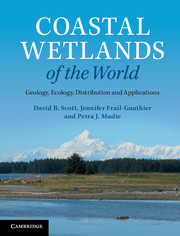Book contents
- Frontmatter
- Contents
- Preface
- List of acronyms and abbreviations
- 1 Introduction: what is covered in this coastal wetlands book?
- 2 Physical aspects: geological, oceanic and climatic conditions
- 3 Zonations and plants: development, stressors and adaptations
- 4 Animals in coastal wetlands: zonation, adaptations and energy flow
- 5 Human intervention causing coastal problems
- 6 Coastal wetlands worldwide: climatic zonation, ecosystems and biogeography
- 7 Examples of North American salt marshes and coastal wetlands
- 8 Examples of South American coastal wetlands
- 9 Africa: selected marsh and mangrove areas
- 10 Europe and Asia: a view of what remains
- 11 Australasia: wetlands of Australia and New Zealand
- 12 Applications in geological monitoring: paleoseismology and paleoclimatology
- 13 Applications in conservation of plant biodiversity and agriculture
- 14 Using mesocosms as a way to study coastal wetlands
- 15 Conclusions and future directions
- References
- Index
- Plate section
10 - Europe and Asia: a view of what remains
Published online by Cambridge University Press: 05 July 2014
- Frontmatter
- Contents
- Preface
- List of acronyms and abbreviations
- 1 Introduction: what is covered in this coastal wetlands book?
- 2 Physical aspects: geological, oceanic and climatic conditions
- 3 Zonations and plants: development, stressors and adaptations
- 4 Animals in coastal wetlands: zonation, adaptations and energy flow
- 5 Human intervention causing coastal problems
- 6 Coastal wetlands worldwide: climatic zonation, ecosystems and biogeography
- 7 Examples of North American salt marshes and coastal wetlands
- 8 Examples of South American coastal wetlands
- 9 Africa: selected marsh and mangrove areas
- 10 Europe and Asia: a view of what remains
- 11 Australasia: wetlands of Australia and New Zealand
- 12 Applications in geological monitoring: paleoseismology and paleoclimatology
- 13 Applications in conservation of plant biodiversity and agriculture
- 14 Using mesocosms as a way to study coastal wetlands
- 15 Conclusions and future directions
- References
- Index
- Plate section
Summary
Key points
Eurasia is the largest continent, but its coastal wetlands have long histories of human occupation and few tidal wetlands remain; temperate salt marshes dominated by grasses and pickleweed occur in Western Europe and the northern Mediterranean; these wetlands are grazed by livestock or used for salt production; extensive microtidal Danube Delta marshes survive as wildlife refugia because of wild pigs and malaria mosquitoes; Mesopotamian and Yangtze basin marshes are highly imperiled by upstream dam construction; Southeast Asia has 10 densely populated delta wetlands in high to extreme danger of survival; tsunamis and tropical storms damage fringe mangroves on coastlines long changed by farming and aquaculture; monsoon floods and tidal surges drown millions of people in China despite giant dams; efforts are being made to replace mangals destroyed for wood, and rice or shrimp farms, and to stabilize mudflats with cordgrass.
Background
The continents of Europe and Asia (Eurasia) make up about one-third of the world’s land area, but the combined acreage of their coastal wetlands is less than in the much smaller Nearctic and Afrotropical landmasses (Ramsar, 2007). Coastal wetlands of both Europe and northern Asia belong to the Palearctic biogeographic province (see Figure 6.5). Eurasian temperate marshes therefore share many common characteristics, particularly large-scale anthropogenic alteration over thousands of years, beginning in the Middle East, Europe and China, which have been ancient centres of agriculture and the locations of first cities since about 9000 yr BP (Roberts, 1998; Riehl et al., 2013). In this temperate region, there are now only two major estuaries: the Rhine Estuary (Netherlands) and the Shatt al-Arab (Iraq); both are seriously endangered by rising global sea level and global warming trends. Further south in Eurasia, the tropical-subtropical wetlands lie in the Indo-Malayan and Polynesian sectors of the Oceanic biogeographic region. Here, ten vast, densely populated estuaries are under moderate to extreme threat of destruction from rising global sea level. The tectonically active Southeast Asian region on the western ‘Pacific Ring of Fire’ is further subject to frequent earthquakes and tsunamis, as well as intense river flooding during the monsoon rain season.
- Type
- Chapter
- Information
- Coastal Wetlands of the WorldGeology, Ecology, Distribution and Applications, pp. 186 - 230Publisher: Cambridge University PressPrint publication year: 2014



